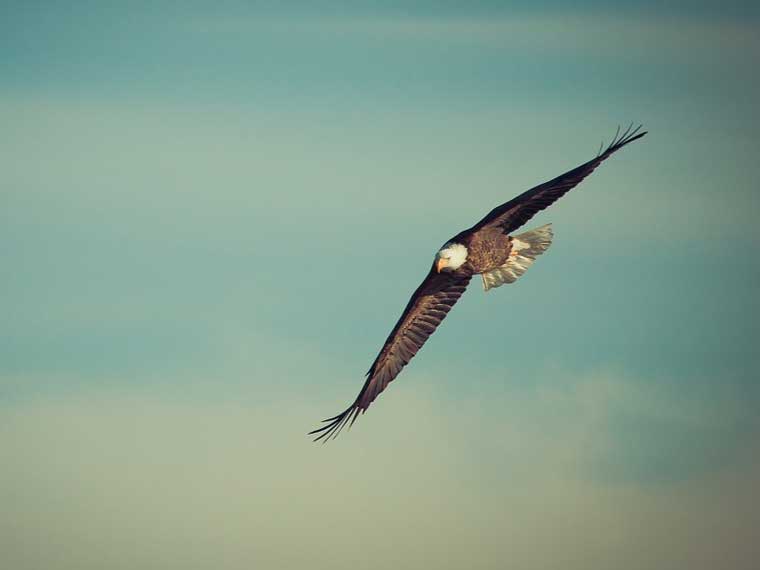You can’t fail to be impressed by eagles. This apex predator has a range of skills will let it rule over the bird kingdom. They don’t have many weaknesses, and that includes their ability to fly at higher ranges than other birds… but can eagles fly above or into storms?
Can eagles fly above storms? Larger eagles, like golden eagles and bald eagles, can fly high enough to rise above many storm clouds. They have been observed at altitudes of up to 11,000 feet, the altitude that many small planes fly at.
That’s the short answer. As you can see, it’s very possible for eagles to fly above storms. But how do they do this, and what about flying into storms? Here’s all you need to know.
How eagles fly above storms
Eagles use strong winds to glide upwards and over storms. This skill lets them to fly great distances with minimal effort. This ability to fly efficiently at high altitudes allows them to migrate as much as 5,000 miles each direction.

Eagles also use their flying abilities to rise high in the sky to spot prey. A bald eagle, for example, can spot moving prey at a distance of 3 miles, then swoop downward at speeds of up to 200 miles an hour, breaking the back of their prey.
There is no evidence, however, that eagles use their high-flying abilities to rise above storms. Scientists observing eagles have noted that eagles sense an approaching storm and usually choose to shelter close to lakes or rivers, in tall vegetation, or in the tops of trees and rock crevices.
That approach makes sense, as eagles attempting to outfly a storm could find themselves in the middle of a large stormfront with no place to land. Eagles are unable to maneuver safely close to obstacles during high winds because of their large wingspan.
Do eagles fly in high winds?
Eagles are able to fly in high winds as they use the wind currents to give them additional lift. Eagles will follow winds currents upward, gaining thousands of feet in elevation during high winds. However, those winds are hazardous to eagles when close to the ground. Eagles are strong flyers but lack the fine control of other raptors, like owls. So a combination of high winds and obstacles is very dangerous for eagles. Normally, eagles tend to land and seek shelter when a large storm approaches.
Are eagles the highest-flying birds?
Eagles have been seen at an impressive 11,000 feet elevation. While that seems like eagles must be the champion flyers, their achievement is eclipsed by Ruppells Griffon Vulture, which has been observed at elevations up to 37,000 feet.
In other words, they fly nearly as high as commercial jet liners, without the benefit of a pressurized cabin or supplemental oxygen. They compensate for the low concentration of oxygen at those elevation by a genetic adaption in their blood.
They have a special type of hemoglobin, the part of blood that carries oxygen, that absorbs oxygen more efficiently. They live a very efficient lifestyle, soaring with little effort high above mountains, using their acute eyesight to spot prey. They normally eat carrion, so can leisurely glide down to their feast once spotted, with no need to pursue or kill prey.
Wonderfully adapted to their environment, they can live up to 50 years in the wild.
Can eagles fly in the rain?
Eagles actually prefer to fly in moist, heavy air as it gives them additional lift. Cooler temperatures associated with overcast days also improve flying conditions. Eagles have acute eyesight tuned to see movement, so are able to see fine and hunt successfully in light to medium rains. So, a lovely day for an eagle is probably a cool day with a light rain.
They can rise high in the air to hunt, or fly as much as 200 to 300 miles during a light rain. A heavy rainfall, though tends to ground eagles as they lose visibility. They tend to find shelter in the tops of trees or among sheltering rocks.
Handy Hint: Something worth noting: eagles hate flying over large expanses of water!
Are eagles endangered?
The populations of some eagles, like bald eagles, plummeted with the use of DDT on crops during the 1950s and 1960s. These chemicals thinned the shells of the chicks, so few survived to hatch.
New laws in the United Stated in the 1970s stopped the use of those pesticides, leading to a resurgence in populations. Bald eagles are now longer endangered – here’s what happens if you accidentally kill onethough!
Other eagles are still endangered. Use of DDT continues in other parts of the world, decimating populations. A lack of prey animals contributes to their declines. Many organizations are working to limit the use of dangerous chemicals and restore habitats.
Characteristics of eagles
Eagles can be found on every continent. These birds of prey vary greatly in size but share 3 distinctive characteristics that distinguish them from other raptors: 8 powerful talons, acute eyesight, and a hooked beak. Eagles are also powerful flyers, with wingspans of up to 3 meters.
Those characteristics combine to create an effective hunting bird, designed to be a meat-eater. Keen eyesight allows them to spot their prey from a distance. Powerful wings allow them to swoop down on their prey at high speeds.
Their talons allow them to grasp prey firmly, and to break the spine of their intended food. Finally, their beak is designed to rend and tear their food, so it can be eaten.
Eagles differ from other large birds of prey in that most of its food is live prey. Most other birds of prey subsist mainly on carrion. Eagles will also eat carrion when available however, live prey is easier for eagles to spot as their eyes detect movement at great distances.
The lifespan of an eagle
Most eagles become adults, acquiring their adult plumage, at 3 or 4 years old. They chose a mate shortly after, and will stay with that mate for life. If one bird dies, the other will normally chose another mate. Eagles use the nest site year after year, as long as they were able to raise chicks successfully the year before.
Eagles will raise 1-3 chicks a year. They will feed the largest chick more, so often only one chick will survive to adulthood. Chicks develop their juvenile plumage, their baby feathers in dark colors, at about 12 weeks, and begin to learn to fly shortly after.
Chicks initially practice gliding downward from branch to branch, developing techniques to glide upward. As the chicks develop more strength, they learn to flap their wings to attain altitude.
By the time the chicks are 3 to 4 months old, they are able to fly with the adults, if their parents migrate. They could fly as much as 5000 miles in their first year!
After migration, the family will return to the same area where the chicks were raised. The parents will normally use the same nest, but the juveniles will find another location nearby to mature for 3 to 4 years, until they acquire adult color and are ready to raise their own families.
You might also like…
- Why bald eagles like to build their nests in high places
- Why eagles have angry expressions on their faces
- Can crows fly as high as eagles can
Photo of an eagle flying above a storm used in header via https://unsplash.com/photos/dJb4w5hy0OA

